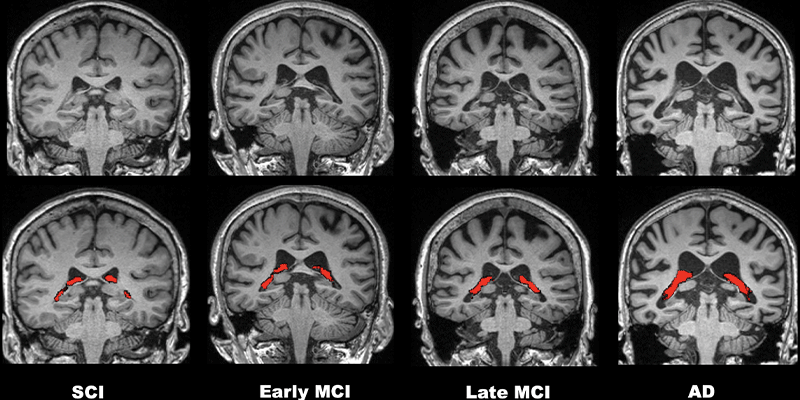Choroid Plexus Volume Linked to Alzheimer’s Disease
Clear relationship found between choroid plexus volume and cognitive impairment severity

Increased volume of the brain’s choroid plexus is linked to greater cognitive impairment and Alzheimer’s disease, according to a new study published in Radiology.
The choroid plexus is a network of blood vessels, connective tissue and cells found in spaces of the brain called ventricles. It is a gateway for immune cells from the blood to the brain. As the primary site for cerebrospinal fluid production, it is crucial to clearing waste products and toxic proteins from brain cells. This role is particularly important in the case of Alzheimer’s disease.
Recent research suggests that disease progression is related to the accumulation of abnormal proteins called amyloid and tau and subsequent degeneration of the nerves.
“Researchers believe impaired clearance rather than overproduction of abnormal amyloid and tau is responsible for Alzheimer’s disease,” said study senior author Won-Jin Moon, MD, PhD, professor of radiology and chair of the Department of Radiology at the Konkuk University School of Medicine in Seoul, Korea. “Thus, we assume that the abnormal status of choroid plexus is linked to the failure of clearance leading to waste and toxic protein accumulation in the brain and failure of immune surveillance leading to neuroinflammation.”
Little is known about the choroid plexus’ imaging profile in cognitive impairment.

Comparisons of four representative 3.0-T brain MRI scans of choroid plexus (CP) volume (red) according to disease stage over the cognitive impairment spectrum. CP volume is greater in the patient with Alzheimer disease (AD) than in those with subjective cognitive impairment (SCI) or mild cognitive impairment (MCI). All patients were 75-year-old women.
Choi et al, Radiology 2022; 000: 1-11 © RSNA 2022
Higher Volume Negatively Associated with Memory, Executive Function
To learn more, Dr. Moon and colleagues performed brain MRI on 532 participants at various stages of cognitive impairment. Of the 532 participants, 132 underwent permeability imaging using dynamic contrast-enhanced MRI.
Choroid plexus volume and permeability were associated with the severity of cognitive impairment on brain MRI. Choroid plexus volume was greater in those with Alzheimer’s dementia than in those without. Higher choroid plexus volume was negatively associated with memory. It also had negative effects on executive function.
“Our study found that the enlarged choroid plexus volume is independently associated with increased cognitive impairment,” Dr. Moon said. “We found no relationship between choroid plexus volume and amyloid pathology but a clear relationship between the choroid plexus volume and cognitive impairment severity.”
The study results point to new possibilities for MRI’s role in the diagnosis of Alzheimer’s disease.
“I think our findings on the choroid plexus can suggest it as a new potential MR imaging surrogate for an impaired clearance system and neuroinflammation,” Dr. Moon said.
Other potential clinical applications include helping researchers develop new target drugs or treatments for clearance failure and neuroinflammation. Eventually, choroid plexus measurements could help speed treatment to those who need it most.
“If we combine choroid plexus volume and hippocampal volume in a screening stage, it may help us better discriminate the more vulnerable patients from the less vulnerable ones,” Dr. Moon said.
The researchers plan to follow up with a longitudinal study. They will explore changes in choroid plexus volume over time as the disease progresses.
For More Information
Access the Radiology study, “Choroid Plexus Volume and Permeability at Brain MRI within the Alzheimer Disease Clinical Spectrum.”
Access the related Radiology editorial, “The Blood-Cerebrospinal Fluid Barrier May Play a Role in Alzheimer Disease Pathogenesis.”
Read previous RSNA News articles on Alzheimer’s disease:
- White Matter Integrity Disrupted in People with Alzheimer’s Gene Mutation
- Researchers Use AI to Track Cognitive Deviation in Aging Brains
- Brain Iron Accumulation Linked to Cognitive Decline in Alzheimer’s disease